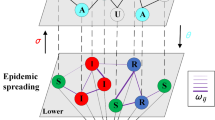Abstract
In recent years, the pure distributed file sharing peer-to-peer network—Kad network has been paid close attention by scholars. However, the study of the controlling problem of information spreading on the Kad network is rare. We found that the traditional infectious model MSEIR is similar with the specific information propagation of the Kad network by studying. But the MSEIR model could not completely and accurately simulate the information dissemination process of the Kad network. Therefore, the model of Kad epidemic dynamic model (KEDM) which has improved the transmission status of the existing MSEIR is proposed. Considering the characteristics of the KEDM model in different time segment, we redefine the relationship between the status transitions. We derived the basic reproduction number of KEDM using the degree function reference model. Data simulation results show that the KEDM can more accurately describe the specific information propagation of the Kad network than traditional MSEIR model. The basic reproduction number can accurately reflect the equilibrium threshold and stability of the specific information propagation in Kad network.







Similar content being viewed by others
Explore related subjects
Discover the latest articles and news from researchers in related subjects, suggested using machine learning.References
http://www.ipoque.com/resources/internet-studies, Ipoque (2009).
Li, M. Y., & Muldowney, J. S. (1995). Global stability for the SEIR model in epidemiology. Mathematical biosciences, 125(2), 155–164.
Pei, Y. Z., Liu, S. Y., Li, C. G., et al. (2009). The dynamics of an impulsive delay SI model with variable coefficients. Applied Mathematical Modelling, 33(6), 2766–2776.
Zhang, T. L., Liu, J. L., & Teng, Z. D. (2009). Bifurcation analysis of a delayed SIS epidemic model with stage structure. Chaos, Solution and Fractals, 40(2), 563–576.
Liu, J. L., & Zhang, T. L. (2009). Bifurcation analysis of an SIS epidemic model with nonlinear birth rate. Chaos, Solution and Fractals, 40(3), 1091–1099.
Yi, G., & Lianhua, W. (2009). A class of the combination of SEIR and SEIS epidemic model with constant recruitment. Editorial Board of Journal of HPU, 2(28), 1–5.
Bin, F., Jingen, Y., & Xuezhi, L. (2009). Stability of an age-structured MSEIR epidemic model with recovery both in latent period and infectious period. Acta Mathematicae Applicatae Sinica, 22(1), 90–100.
Huang, J., Yin, B. Q., Guo, D., et al. (2010). An evolution model for P2P file-sharing networks. In The second international conference on computer modeling and simulation, Sanya (Vol. 2, pp. 361–365)
Jiang, Q., Xi, H. S., & Yin, B. Q. (2009). Dynamic file grouping for load balancing in streaming media clustered sever systems. International Journal of Control, Automation and Systems, 7(4), 630–637.
Carra, D., Michiardi, P., Salah, H., et al. (2013). On the impact of incentives in eMule. IEEE Journal on Selected Areas in Communications, 31, 94–104.
Tu, M., & Ma, H. (2013). Data placement in P2P data grids considering the availability, security, access performance and load balancing. Grid Computing, 11, 103–127.
Wang, R., & Cai, W. D. (2015). A sequential game-theoretic study of the retweeting behavior in Sina Weibo. The Journal of Supercomputing, 71(9), 3301–3319.
Ribero-Angeles, M. E., & Rubino, G. (2010). Priority-based scheme for file distribution in peer-to-peer networks. In The IEEE communications conference, Cape Town (pp. 23-27)
Zhang, H., & Yin, B. (2012). A dynamic model of BitTorrent-like P2P file-sharing system. In The 31st Chinese control conference, Hefei (pp. 5513–5517)
Inaba, H., Meguro, K., et al. (2007). Age-structured homogeneous epidemic systems with application to the MESIR epidemic model. Mathemtical Biology, 54(1), 101–146.
Arild, W. (2012). On nonlinear age-and stage structured population models. Mathematics and Statistics, 8(2), 311–322.
Zhang, S., & Zhou, Y. (2013). Analysis and control of an epidemic model with media influence. Chinese Journal of Engineering Mathematics, 30(3), 416–426.
Lindenstrand, D., et al. (2013). Estimation of the Malthusian parameter in an stochastic epidemic model using martingale methods. Mathematical Biosciences, 246, 272–279.
Becker, N. G., & Rouderfer, V. (1996). Simultaneous control of measles and rubella by multidose vaccination schedules. Mathematical Biosciences, 131, 81–102.
Author information
Authors and Affiliations
Corresponding author
Rights and permissions
About this article
Cite this article
Wang, R., Cai, W. & Shen, B. The study of the dynamic model on KAD network information spreading. Telecommun Syst 63, 371–379 (2016). https://doi.org/10.1007/s11235-015-0127-1
Published:
Issue Date:
DOI: https://doi.org/10.1007/s11235-015-0127-1




